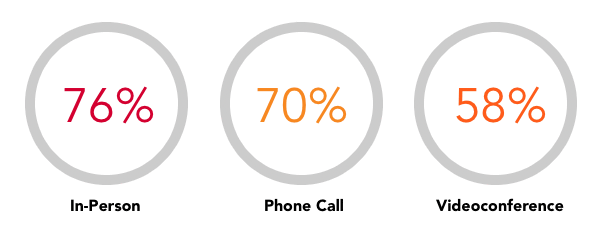From 2018 to 2021, the percentage of clients who want to work with a lawyer remotely grew considerably, from 23 percent to 79 percent.
However, according to research published in Clio’s 2021 Legal Trends Report, clients’ appetite for a video interaction varies depending on the stage of the matter. Lawyers looking to build strong client relationships should heed these preferences and adjust their schedule tactics accordingly.
In 2018 – those fancy-free times before COVID-19 – no more than 4 percent of clients wanted to communicate by videoconference at any stage, according to Clio. As remote work has become more commonplace, that’s changed; for many stages of a matter, more than half of consumers are open to a Zoom meeting (or Teams or Google Meet, et cetera). However, it’s important to note that at no stage is videoconference the No. 1 choice.
First Meeting or Consultation:
As this is a critical time to establish rapport, it’s not surprising that 76 percent of clients want an in-person meeting. Phone calls are the second choice, with 70 percent; videoconferencing appeals to 58 percent.
Receiving Status Updates on the Matter:
While 60 percent of clients are open to videoconferences, it’s the fifth-most popular choice, behind phone (73 percent); in-person (68 percent); email (66 percent); and a client portal (61 percent). Clio notes, “More informal and asynchronous options – the types of interactions that don’t need to happen in real time – have higher preferences among consumers…at these points in a matter, less formal options that allow clients to review information at their convenience may be a better option for many.”
Communicating About Key Decisions:
High-stakes discussions mirror client preferences for the first meeting, with respondents preferring in-person meetings (75 percent), then phone (71 percent), then videoconference (61 percent). Clients want immediacy and the ability to discuss options in real time; these interactive channels beat email and secure client portals handily.
Viewing and Sharing Documents:
Simply put, your clients do not want to review paperwork by Zoom. It was respondents’ sixth choice, trailing the in-person meeting (71 percent) and a cadre of tech solutions: email (63 percent), secure client portal (60 percent), online file sharing service (56 percent) and secure mobile app (52 percent).
Consider the patterns here. The effects of a global pandemic notwithstanding, not much has fundamentally changed: For big decisions, such as choosing who to hire or weighing actions in a legal matter, people want human connection. For passive interaction, such as receiving a status update or reviewing a document, people want some flexibility and autonomy.
What does this mean for your client development?
Know the prospect.
Some demographics are more open to videoconference than others. In terms of age groups, Clio reports that Gen X has the highest preference for working remotely, at 72 percent; Millennials are next, with 69 percent. Baby Boomers are the most reticent to go remote, at 59 percent.
There also is a marked difference when it comes to legal sophistication: Individuals who had hired a lawyer before were 18 percent more likely to be comfortable with videoconference meetings.
Meet people where they are, and offer choices when you are able.
Acknowledge the limitations.
As we all know very well by now, videoconferencing is far from a perfect medium. There are challenges to building meaningful connections through a screen.
For one, participants may be distracted. In a 2021 survey by Researchscape International, 39 percent of U.S. respondents said they were often distracted on videoconferences. Specifically:
- 30 percent said they have read the news or cruised social media during a Zoom;
- 28 percent have gone to the bathroom;
- 25 percent said they often multitask.
In addition to not getting your clients’ full attention, know they may feel disconnected from you as well. In the same survey, 26 percent of U.S. respondents said they feared people misinterpreted their facial expressions or body language, and 22 percent said they did not feel understood or “heard” on videoconference.
Advocate for your clients’ best interests on Zoom. A simple branded background will help them focus on you, not on your surroundings. (This is especially important if you are working from home, and there are four-legged creatures running about.) Ask clarifying questions. Do not rush. Repeat your clients’ statements back to ensure full comprehension.
Remember the fundamentals.
Remote options are growing in importance, to be sure; in the Clio report, 79 percent of clients say Zoom availability has a “very positive” or “somewhat positive” influence on their selection of a lawyer.
However, your prospects rank many other factors as more important, among them:
- Responsiveness – 86 percent;
- Price transparency – 85 percent;
- Positive online reviews – 82 percent;
- Personal recommendations – 81 percent; and
- Online presence – 80 percent.
People want to hear back from you; they want to know what to expect; and they want assurance that you are a safe choice – either from trusted friends or strangers on the Internet. And then they want the option to Zoom with you.
As always, successful legal marketing comes down to empathy: Deploy videoconferencing after you have established a face-to-face relationship. Offer it as a choice. Be fully present, and help your clients be fully present as well.
(And please do not be among the 28 percent of people who go to the bathroom during a videoconference.)

